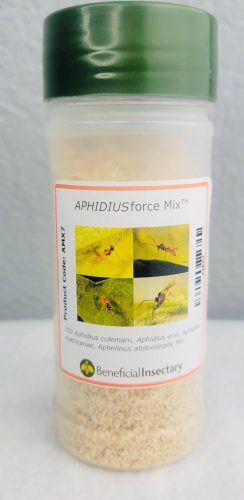APHIDIUSFORCE™ MIX
APHIDIUSforce™ Mix
APHIDIUSforce™ Mix is a combination of four parasitoid wasp species that will attack many common pest aphids.
Aphidius colemani
Aphidius ervi
Aphidius matricariae
Aphelinus abdominalis
Small Aphid Species
Green Peach Aphid (Myzus persicae)
Melon/Cotton Aphid (Aphis gossypii)
Black Bean Aphid (Aphis fabae)
Cannabis Aphid (Phorodon cannabis)
Potato Aphid (Macrosiphum euphorbiae)
Fox Glove Aphid (Aulacorthum solani)
Cannabis Aphid (Phorodon cannabis)
Pea Aphid (Acyrthosiphon pisum)
Lettuce Aphid (Nasonovia ribisnigri)
Ornamentals
Hemp/Cannabis
Vegetable Crops
Soft Fruits
Tree Nurseries
Greenhouses
Indoor Facilities
Fields
Gardens

Female wasps hunt for aphids by sensing infested plants’ odor and the aphid’s honeydew secretions. Upon discovering aphids, the female wasp will touch them with its antennae to make sure they are an appropriate species. The female wasp will use an ovipositor to insert an egg inside the aphid if they are. Once the egg hatches, the larva begins to eat the aphid from the inside, eventually resulting in death 7 to 10 days later.
Once the larva kills the aphid, it will spin a cocoon around itself, and the aphid will turn into a bronze-colored mummy. The wasp will pupate for 7 to 10 days before emerging as an adult. The adult wasp chews a round exit hole out of the back of the aphid. Each female wasp can lay up to 300 eggs, most of them during the first four days of adulthood.
Use immediately upon receipt.
This product can be briefly stored at 6-8° C / 43-46° F and RH> 85% if not possible. Always adhere to the use-by-date.
RELEASE MOMENT
APHIDIUSforce™ mix can be released preventatively. Once aphids are detected, increase the dosage rate in line with pest density.
RELEASE METHOD
Sprinkle the content on the flat leaves or into release boxes and hang it in the plants/crops. Do Not place mummies directly onto soil or substrate. Ensure the product contents remain dry and are not moved from the introduction site for a few days.
Mummies can be observed on leaves of the crop 10-14 days after the first application. Note that Aphelinus abdominalis produces black mummies, whereas the other three species produce golden/brown mummies. A perfectly round hole at the back of the mummy indicates that an adult wasp has emerged. Control should be achieved once 80% of the aphids are parasitized. The efficacy can be checked by observing a reduction in the pest population, reduced hotspots, and healthy plant growth, free of honeydew or sooty mold.
Remove yellow sticky cards for the first few days after the wasps are released. Blue sticky cards are acceptable to keep the entire time.
Live-Product: Beneficial Insectary strives to guarantee the live delivery of the freshest organisms to our customers. We offer replacements or credits for any compromised shipments to our customers that report any issues or concerns within 24 hours. These issues or concerns must be relayed before releasing any organisms that are suspected of having viability issues. Please do not discard the product. You may be requested to return the shipment for further analysis.
Establishment of BCAs in Crop Settings: Many variables can negatively or positively impact BCA and pest populations in various crops we work with (pesticide applications, watering practices, improper storage methods, cultural/physical/mechanical controls, etc.). Some beneficial organisms require a steady pest presence as a food source to build their population. Others may require alternate food sources, such as pollen or nectar as an example. While other BCAs have specific photoperiod requirements for success. Due to these variables, we cannot guarantee the long- or short-term establishment of the BCAs we sell after the release of the organism(s). We will not offer refunds, discounts, or other credits on products that have already been released. Please adhere to our “Live-Product” disclosure.
PRODUCT Release Method
PRODUCT SPECIFICATIONS
PRODUCT | PACKAGE SIZE Filler/Carrier | LIFE STAGES | PRODUCT CODE |
|---|---|---|---|
APHIDIUSforce™Mix – 750 | 100ml Bottle w/ Buckwheat | Mummies / Adults | AMX7 |
RELEASE RATES
CLASSIFICATION | RELEASE INFORMATION |
|---|---|
Preventative | 1-5 per 100 sq. ft., weekly |
Hot Spots | 5-25 per 100 sq. ft., weekly |

CANNABIS ALERT: Release rate suggestions on these pages are usually not sufficient for cannabis growers. For cannabis release rates contact us.
Life Cycle
EGG STAGE
- Eggs are laid inside the host aphid
LARVAL/PUPAL STAGES
- The Larvae and Pupae develop inside the host aphid
ADULT
- Aphidius colemani and A. matricariae: Dark colored, 2 to 3 mm in length with long antennae
- Aphidius ervi: Dark colored, 3 to 4 mm in length with long antennae
- Aphelinus abdominalis: 2.5 – 3 mm in length with short legs and antennae. Their head and thorax are black, and their abdomen is yellow
